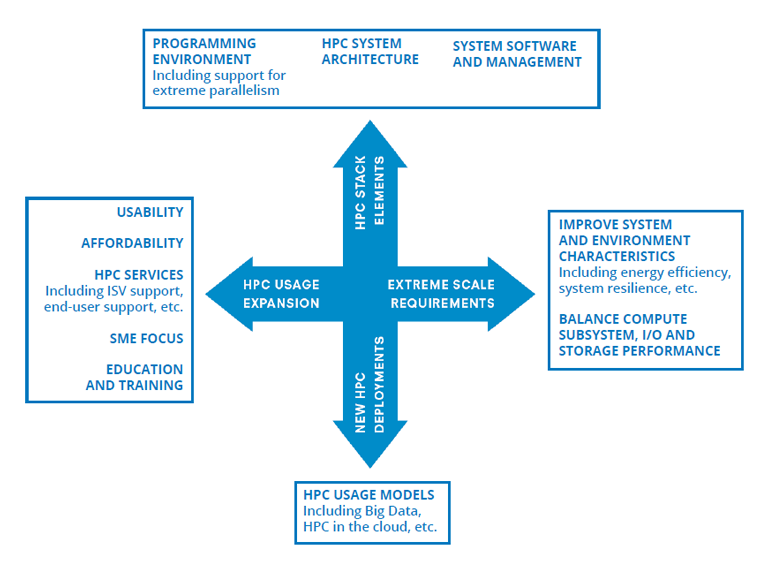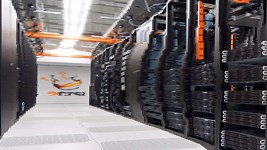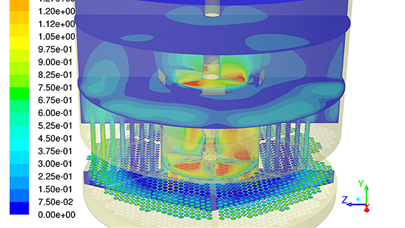A 360° vision
The first of these four dimensions, HPC Stacks Elements, represents the evolution and improvement of the fundamental hardware and software elements that make up high-performance computing systems of any size and scale.
The stack of these elements and subsystems is mainly made up of hardware components and architectures (processors, memory, network…), system and management software (OS, configuration management, resources management…) and programing environments (taking into account massive parallelization and with a special focus on API standardization).

Fig. 1 – From a multidimensional vision, the ETP4HPC SRA identifies the major technical areas leading to coordinated action plans. Ultimate goal: that the whole be greater than the sum of its parts.
The second dimension, Extreme Scale Requirements, identifies the conditions needed to successfully move to Exascale and beyond. The integration of elements from the first dimension at these levels requires a global, transverse vision of the many problems that are exacerbated at such large scales: energy efficiency, resilience, balancing performance between computation, communications, storage, etc.
The third dimension, new HPC Deployments, includes new HPC usages – the Big Data, the Cloud, embedded computing, real-time… – and defines ways of stimulating and supporting them. This dimension is distinguished by its highly technical content. In effect, various ambitious developments are needed, for example when it comes to algorithms (data processing, extracting meaning and value…) and system tools (managing remote access modes, virtualization, workflow management…).
The fourth dimension, HPC Usage Expansion, is the one dedicated to the development and democratization of HPC usage. Here we leave the purely technical realm to look at equally important actions, to do with the economy and education/training, amongst other things. These actions require co-ordinated relationships with other players, with a view to developing the overall ecosystem mentioned earlier. First and foremost, it will be about facilitating access to various levels of computing resources, promoting their use and optimizing the costs of purchasing and ownership. In parallel, the SRA recommends stimulating the development of a services sector (porting, optimization) which would be particularly useful for ISVs and industrial users, as well as supporting SMEs working on HPC technologies. Finally, it seems essential for all those involved to contribute to HPC training and education. This is area, training programs focused on HPC usage are seen as equally important as those focused on HPC technology.
HPC in Europe and its value chain
HPC is strategic for research, industry, the economy and our society as a whole. The European Commission formally set out this vision in its February 2012 communication, and following this the Competitiveness Council reaffirmed its willingness to launch a dedicated program on 30 May 2013.
The aim of this program is for the Old Continent to strengthen its position as a major player in the use of HPC, and to use this position to improve its industrial competitiveness and scientific leadership. Europe has all the necessary expertise to design and develop supercomputers and software at the highest level in the world. So it is possible to put in place a comprehensive, sustainable and competitive ecosystem, within the European Union, around HPC technologies.
This ecosystem could be set up by locating its three main cornerstones along a value chain that links technologies to their uses. Based on this vision, ETP4HPC’s role is to encourage the development of the necessary HPC technologies in Europe, on a spectrum spans from hardware components to software tools, and to stimulate the development of complementary services, including access to computing resources, code optimization, etc. By doing this, ETP4HPC embodies the technology providers’ response to the expectations and ambitions of the European Commission.
The second cornerstone of the value chain consists of bodies such as the pan-European computing infrastructure PRACE, and institutional and private computing centers who use and implement HPC technologies (providing access to computing resources, associated services…). The third cornerstone – Applications and usages – brings together all kinds of users from the worlds of research and industry, for whom computer simulation and HPC represent increasingly indispensable tools.
In order to effectively fulfill its role, ETP4HPC has already built up the necessary links with other players and initiatives evolving within this ecosystem. This applies, in particular, to the European Exascale Software Initiative (EESI), which is proposing a roadmap to transform applications to operate at the exascale level by the end of the current decade. It also includes a representative majority of industrial HPC users and computer simulation software vendors.
© HPC Today 2024 - All rights reserved.
Thank you for reading HPC Today.






























